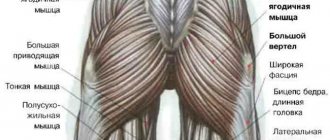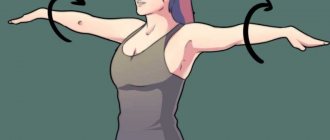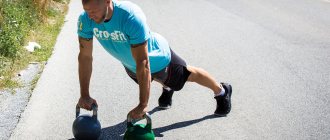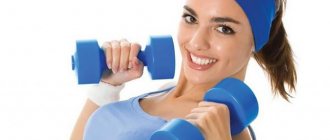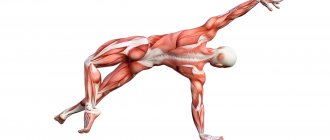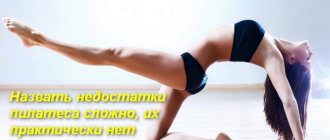Fitball is a multi-colored gymnastic equipment made from elastic material, so durable that you can sit, lie, or jump on the ball. Withstands loads up to 300 kg. Manufacturers offer a huge selection of exercise machines - for every taste and budget. Balls are available with hypoallergenic coatings to give people with latex allergies a chance to exercise.
Make sure that during classes the ball does not come into contact with objects with sharp edges, with clothing - in the presence of jewelry and lightning that can tear or puncture the ball. Clothes for classes should be tight-fitting to the body (a top or short shorts are better), a wide, loose suit can be wrapped around a ball. The sole of the shoe should not slide on the surface.
Fitball for exercises
How to choose a projectile
The diameter of the ball varies in the range of 35 – 180 cm. Small ones are designed for exercising arm muscles, large ones are megaballs, for outdoor entertainment.
For daily training, balls with a diameter of 45–75 cm are used. The choice depends on the person’s height:
- 45 cm – up to 158 cm;
- 55 cm – 158-168 cm;
- 65 cm – 169-179 cm;
- 75 cm – 180-190 cm.
To check if the ball fits, you need to sit on top with your feet on the floor at a 90-degree angle.
What should a fitball be like?
The subsequent effectiveness of all training depends on the correct choice of a gymnastic ball, since an incorrectly selected size of the equipment will not allow you to exercise with it at full strength.
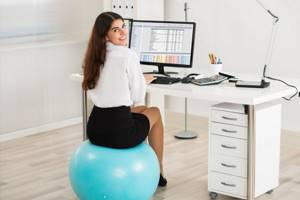
A fitball that is too small will slip out from under a person, and a fitball that is too large will cause the exerciser to slip.
Fitness balls come in three types:
- small, with a diameter of 55 cm;
- medium, the diameter of which is 65 cm;
- large, their diameter reaches 75 cm.
Small gymnastic balls should be chosen for people whose height is from 149 to 164 cm. Medium ones are intended for those whose height is 164-171 cm, and large ones can be bought for people with a height of 180 cm and above.
But there is another way to choose:
- you need to sit on the fitball you liked in the store, keeping your back straight and your feet in front of you;
- after this, you should try to bend your knees so that they form an angle of 90 degrees;
- if this works and the fitball does not bend under the weight of a person, then the size is appropriate.
Balls with hard, elastic spikes are worth buying for people who have pronounced cellulite on the buttocks and thighs. The spikes have a massage effect, and with regular exercise they break down subcutaneous fat.
When purchasing, beginners should pay attention to ball models with special holders, as they will reduce the risk of injury and simplify the process of practicing.
Who is the training for?
Exercises with a fitball are recommended for people of all ages. For many years, the ball has been used for medical purposes for the rehabilitation of patients suffering from orthopedic diseases. A participant in regular training primarily improves physical condition, strengthens the muscles of the legs, back, abs, buttocks, inner and outer thighs. Such exercises are great for relieving stress and anxiety.
Classes are broken down like this:
- for older people (program 50+);
- special training for pregnant women, restoration of physical fitness after childbirth;
- classical, where ball exercises are included in fitness training;
- specialized programs - rehabilitation and preventive.
Balancing on a ball activates the body, strengthens the skeletal muscles responsible for maintaining correct posture, increases joint mobility, improves coordination, and helps get rid of difficulties associated with the vestibular system. The classes help people with neurological disorders. The main help for women is to shape the body: reduce the volume of the hips, make the buttocks firm, flatten the stomach, tighten the leg muscles.
Trying to control a gymnastic ball uses deep muscles that are difficult to work with other exercise machines. After a set of exercises, correct posture is formed, the woman begins to move with grace and charm, and forgets about problems with the spine.
We will describe a training program for strengthening the abs, buttocks, thighs and legs. The exercises are used for independent training.
Contraindications to exercising with fitball
Exercise with a Swiss ball is not recommended for people with diseases of the cardiovascular system, pathologies of internal organs or intervertebral hernias.

Women after childbirth can begin exercise only with the permission of a doctor.
If a caesarean section was performed, then it is better to forget about the fitness ball in the first 8 months after the operation.
And even if there are no health problems, before starting training you should visit a doctor and consult with him - it may turn out that you will need an individual training plan.
Exercises for abdominal muscles
The main task is to remove lethargy and tighten the abdominal muscles. The exercises are extremely simple, differ from regular exercises in the ease of training: performing on a fitball is noticeably easier, the effect is noticeable quickly.
- Spread your legs shoulder-width apart and place the ball in front. Palms are on the ball. We slowly roll forward slightly, the body reaching for the ball. The back is straight. At the same time, we do a shallow squat, knees bent at an angle of 45 degrees. We do not change the position of the legs.
- Take a wide stance: place your feet shoulder-width apart. We take the projectile, raise it to chest level, arms are bent at the elbow and alternately make turns to the right and left. Can you feel your abs? At first, slowly, as far as possible, without fanaticism. When tension occurs, return to the starting position.
- We do the previous exercise, speeding up the turns and reducing the amplitude. The upper body rotates along with the fitball. The oblique muscles of the abs, arms and back are involved. To finish, it is possible to describe a “figure eight” or “wave” several times in the air with the ball.

Side turns - We sit on the ball, our back is straight, we slowly roll over, and lie down on our back. Exercises where you need to change the sitting position to a lying position are performed exclusively in this way! If you plop down on the ball with your back, you may miss, fall and get injured. Hands behind your head, elbows in a straight line. We lift exclusively the upper part of the body. Without changing body position, we pump up the abdominal muscles with turns to the right and left. The rhythm can be slightly accelerated. Make sure that the lower back does not sag: the load on the back greatly increases, the muscles of the buttocks are incorrectly stretched.
The described exercises are suitable mainly for beginners. Here is a description of a workout with a higher load:
- Let's kneel down. We lean our right side on the ball. We leave the right leg bent in its original position, extend the left leg, move it to the side, and rest the toe on the floor. You need to monitor the position of your legs. Hands behind head. We make shallow bends to the left. We change sides.
- We lower ourselves to the floor, the fitball is clamped between the ankles, hands behind the head. We raise our legs extremely slowly at first to 45 degrees. Lowered to original position. We raise it to 90 degrees. The upper body remains motionless and does not come off the floor. The exercise works well the muscles of the buttocks.
- We lie down on our shoulder blades, the ball is sandwiched between the bones of our feet, and our hands behind our heads. Slowly bend your knees to a right angle and return to the original position. With a new movement we try to pull our legs as close to our chest as possible.
- The position of the torso is as in the previous exercise. Arms extended above head. Slowly raise our legs and arms at the same time, touch the ball with our palms, and return to the starting position. We feel the muscles of the legs.

Raising legs and arms with a fitball - A similar exercise, you don’t just need to touch the fitball, but take it and press it back to the starting position.
- We kneel down, lie on our stomachs on the ball, hands behind our heads, elbows spread out to the side as much as possible. Shallow bends forward and backward. Keep your back straight.
- We kneel down, the ball in front of us. We place our elbows on the ball and swing on our hands for a short time.
- Clasp your hands together and place your elbows on the ball. Slowly raise your body and straighten your back. We return to the starting position.
- Roll over the ball so that the ball occupies a natural depression in the back, hands behind the head, pumping up the abdominal muscles.
Exercises with a gymnastic ball are performed carefully, without jerking. You need to rise and fall carefully, do not fall back, and watch your lower back. The head is in a neutral position; you cannot lower it or press your chin to your neck. Pay special attention to the positioning of your feet.
Exercise technique
You must stand over the ball to lift it correctly. If your legs and knees have an angle equal to the floor surface, the apparatus is ideal for you.

- Before you start exercising with a fitball, you should warm up a little. This minimizes the risk of muscle damage.
- Do 1-3 sets of 15-30 repetitions. If you feel good, you can increase the repetitions.
- Exercises should be performed slowly, focusing on a specific muscle group. Also watch your breathing.
- Pause up to 1 minute between sets.
- After completing your workout, do some stretching.
- For the desired effect, you need to exercise at least twice a week.
Note! If you are using a fitball for post-traumatic rehabilitation, you need to contact your doctor to choose a training complex.
Training problem areas
For the buttocks, working out the inner and outer parts of the thighs, and legs, squats and bends are suitable, as in regular exercises. The exercises are complex, but significantly effective for modeling these problem areas:
- Bridge with fitball. We lie down on the floor, shoulders pressed to the floor. Feet on the ball. The arms are extended along the body, slightly apart, palms down. Smoothly lift the pelvis up to the end. We don't lower it. On the way up, tighten your hips as much as possible. When we lower it, inhale, when we raise it, exhale. Without changing position, we bend the knee joints of our legs, walk on the ball with our feet, add load to the back of the thighs, and work the leg muscles. We lower ourselves carefully, feeling every vertebra. We finish the exercise by pulling our knees to our chest.
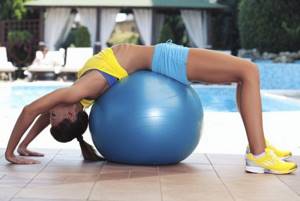
Climbing to the bridge - We pull our right leg towards ourselves as far as possible (everyone has an individual amplitude), opening the knee tendon, the second foot touches the ball. We stretched, then we bent the first leg, placed our foot on the second knee, stretched without tension, felt the muscles of the buttocks. Repeat with the left leg.
- Swing your legs on a fitball. Starting position: lie on the ball with your stomach, arms under your shoulders, hands on the floor. We raise our legs one by one, without bending them. Emphasis on toes.
- We walk two steps forward with our hands, our hips remain on the fitball. Raise your legs to pelvic height. Focus on your hands, raise your legs one by one, but higher than the previous approach. We feel the tension in the hips and buttocks. Try not to strain your back and suck in your stomach.
- We place our foot on the ball, straighten our leg, and roll the fitball from toe to heel. Keep the body straight. It is possible to add squats to the exercise, reaching up with your arms. Then we place our hands with our palms on the ball, move our leg back, and return to the starting position. Repeat with the second leg. This exercise is great for training your abdominal and leg muscles.
- The shoulders and head are on the fitball, the body is straight, the legs are bent at the knees at a right angle. We rest our hands on the floor. We lift and straighten the first leg, hold it for a few moments, then we need to change legs. It is important to not lower your hips when lifting your leg. Make sure that your shoulders and neck remain relaxed, and only the muscles of the lower back, buttocks and abs are tensed. The exercise will become more difficult if you lift your hands off the floor and place them on your belt or hips.
- The press is on a fitball. Palms rest on the floor, feet on tiptoes. Raise your right arm and left leg at the same time. We reached for them. The neck muscles are relaxed, keep your head straight, do not tilt.
Exercises with a fitball for problem areas are recommended to be performed comprehensively, in combination with other methods of body shaping: massage, anti-cellulite wraps, diets. You will simply fall in love with the simulator, feel the fullness of life, and leave several years behind. Daily efforts will definitely bring stunning results.
Lower body exercises
This group of exercises is designed to work the core muscles of the legs.
Squats with a ball over your head
The basis of the exercise is regular squats, the difference of which is that you hold the ball above your head with outstretched arms.

Wall Squats
This exercise uses a ball to support your back. During training, you need to move it from the lower back to the shoulders.
Squeezing the ball with your thighs
It may seem funny, but the workout is great for working out the muscles in your legs and back. Squeeze the ball to maintain balance. Stay in this position for 30-45 seconds.
For this exercise, it is better to use a smaller ball than usual.
Pelvic lift
Lie on the floor and spread your arms perpendicular to your body. Place the bottom of your heel and shin on the ball. Use your abdominal muscles and glutes to lift your hips off the floor. You will be in a precarious position, so keep your arms extended to maintain balance.
Exhale and slowly bring your knees towards your hips so that your feet are on the surface of the ball. Hold this position for a while, then inhale and spread your legs back. Always keep your hips elevated to maximally engage your glutes.
Squats while holding the ball in front of you
This workout instantly works the muscles in your arms, stomach, and legs.
Lunges with ball
When performing this exercise, make sure that the knee of the leg on the floor does not extend beyond the toes. You may want to hold a support (such as a chair) for balance.
Reverse hyperextension
Exercise ball exercises for babies and schoolchildren
There are also exercises for kids with a fitball. Exercises are performed at least two weeks after birth, and not immediately after feeding. When a child gets used to the ball, exercises should be short, and the child should not be undressed.

Rocking on a ball is useful for the proper formation of the vestibular apparatus. The child can perform smooth movements that will help relax the abdominal muscles, eliminate bloating, colic and gas in the stomach, and improve breathing. Gymnastics has a positive effect on the spine, making it strong and elastic, and strengthens the nervous system.
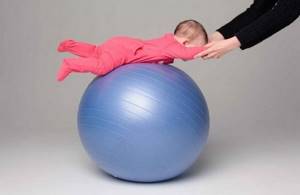
Jumping on a ball is very important for breastfeeding women, as it helps them return to normal life after childbirth and maintain muscle tone. Activities with your child will help him calm down and rock him to sleep.
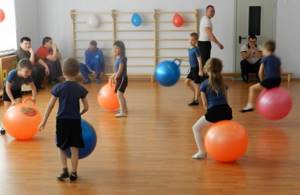
There are many common fitball exercises for schoolchildren. They can be a replacement for morning exercises. With their help, the child's muscles are strengthened and the sense of balance is improved.
